

RISK ASSESSMENT OF ENGINEERED NANOMATERIELS Lang Tran Institute of Occupational Medicine Edinburgh, UK NanoSafety and NanoCode Project Outputs, Prague 1 st November 2011
STRUCTURE OF THE TALK • Exposure Assessment approaches • Hazard Assessment approaches • Risk Assessment Approach – Derivation of Control Limit • Risk Management Strategy
EXPOSURE IN RISK ANALYSIS
EXPOSURE • Emission – Extent – Duration – Background • Mode of Exposure – Inhalation – Ingestion – Dermal – Intravenous injection
EXPOSURE PATHWAYS RS Report Nanoscience and nanotechnologies (2004)
LIFE CYCLE OF ENP
METRICS FOR EXPOSURE-DOSE-RESPONSE
PARTICLE CAUSE LUNG DISEASE Coal Quartz, asbestos Asbestos
TARGET ORGANS FOR NANOPARTICLES EFFECTS Gut Lungs Cleared from lungs In air In foods and drinks Skin Lungs, endothelium , RES Present in cosmetics Medical nanoparticles Deposition from air
FROM EXPOSURE TO INTERNAL DOSE Hypothetical T oxico-kinetics of Nanoparticles N a n o p a r t i c l e s Nose Brain Lung Skin gut blood liver endothelium spleen heart atherogenic plaques
From Internal Dose to Response Role of inflammation and oxidative stress in disease Combustion-derived nanoparticles This also represents the dominant hypothesis for new nanoparticles Free radicals / oxidative stress Inflammation Cancer Asthma COPD Cardiovascular Scarring disease lungs
Pathogenesis of atherothrombosis Plaque rupture and Thrombosis Unstable angina Myocardial infarction CV death Endothelium INFLAMMATION Atherosclerosis Adapted from Libby P. Circulation. 2001;104:365-372.
Nanoparticles-brain and blood .
Translocation of inhaled nanoparticles to the brain Rats exposed to radioactive nanoparticles of carbon 1.5 m g C 13 /gram organ 1.0 Lung 0.5 Olfactory Cerebrum Cerebellum 0.0 7 0 1 2 3 4 5 6 Days after Exposure Oberdorster, G., E. Oberdorster, and J. Oberdorster. 2005. Nanotoxicology: an emerging discipline evolving from studies of ultrafine particles. Environ Health Perspect. 113:823-839.
Why be concerned about exposure to nanotubes? Asbestos/ fibres ? Nanotubes Multi-walled carbon nanotubes 50mm x ? <100nm Nanoparticles Asbestos
ASBESTOS RELATED DISEASES 16
FIBRE PATHOGENICITY PARADIGM 17
AERODYNAMICS OF LONG FIBRES 18
PANEL OF FIBRES AND MWCNT 19
PLEURAL INFLAMMATION ONLY LONG CNT ARE INFLAMMOGENIC IN PLEURAL SPACE OF MICE 20
PERSISTENT INFLAMMATION IN PLEURAL SPACE BY LONG CNT 21
SIMILAR RESPONSES IN PLEURAL AND PERITONEAL CAVITIES TO INSTILLED CNT PANEL 22
FURTHER VERIFICATION 23
MECHANISMS FOR MWCNT TOXICITY 24
UNCERTAINTY ANALYSIS
RISK ASSESSMENT • Monte Carlo (MC) Method to simulate the cumulative exposure and obtain a frequency distribution of Exposure values. For the hazard of ENP, we will estimate the Derived No Effect Level (DNEL) • of exposure based on the most sensitive target organ. Due to uncertainty, we will not obtain a single point estimate of a DNEL but • a frequency distribution of DNEL values. A Risk Index (RI) such as the ratio of Exposure to DNEL will be calculated. • From the distribution of the RI values, informative parameters, like the ‘expected RI’ or the probability that RI is greater than 1 can be derived. These parameters are important to risk managers.
THE PARADIGM OF RISK MANAGEMENT Fundamental to the Strategy for Occupational Health and Safety with Nanotechnology is the Risk Management Paradigm
CONCLUSIONS • Control limit for exposure to Engineered Nanomaterials is essential for Risk Assessment • Nanomaterials have high surface to volume ratio and this will lead to low mass based control limit • e.g 7 µg/m 3 for carbon nanotube • Can the workplace exposure be controlled at such low (mass based) level of exposure? • If this is not feasible then we must look forward to a new generation of engineered nanomaterials that are: • SAFE BY DESIGN • i.e. We must understand which physico-chemical characteristics of nanomaterials can drive the toxicity and design new industrially useful nanomaterials without these features
Recommend
More recommend